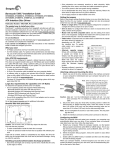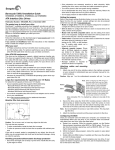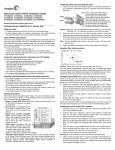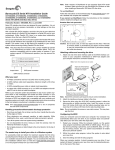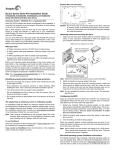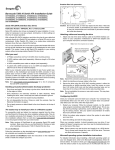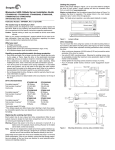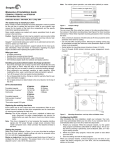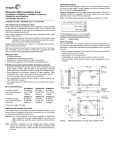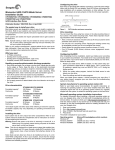Download Seagate 9 - U Series CE 9 Installation guide
Transcript
Jumper settings for this drive are shown below Drive is master or single drive Drive is slave U Series 9 ce Installation Guide Use cable select ST3160022ACE, ST3120025ACE and ST380012ACE ATA Interface Disc Drives Drive is master with nonATA-compatible slave Publication Number: 100271708, Rev. B, December 2003 The easiest way to install your drive DiscWizardTM, available exclusively from Seagate, provides you with customized installation instructions for your hard drive. You can download DiscWizard for free from the Seagate web site at www.seagate.com/support or run the program directly from your web browser. In either case, you should run DiscWizard before you install your drive. If you cannot run DiscWizard, follow the instructions on this installation sheet to install and configure your drive. What you need • A Phillips screwdriver and four 6-32 UNC drive mounting screws • Forced-air ventilation to provide adequate drive cooling • An ATA interface cable. For optimum drive performance and data integrity, we recommend using an 80-conductor Ultra ATA/100 cable (which can be identified by its blue, gray, and black connectors). Handling precautions/Electrostatic discharge protection • Disc drives are fragile. Do not drop or jar the drive. Handle the drive only by the edges or frame. Keep the drive in the protective SeaShellTM container until you are ready to install it to minimize handling damage. • Drive electronics are extremely sensitive to static electricity. While installing the drive, wear a wrist strap and cable connected to ground. • Turn off the power to the host system during installation. • Do not disassemble the drive; doing so voids the warranty. Return the entire drive for depot service if any part is defective. • Do not apply pressure or attach labels to the circuit board or to the top of the drive. Breather filter hole precaution Master/slave jumpers (see table for key to jumper settings) 2. Mount the drive and attach cables a. Slide the drive into a 3.5-inch drive bay. You can mount the drive in any orientation, but we recommend mounting with the circuit board down. Note. To mount the drive in a 5.25-inch drive bay, you must purchase mounting brackets, available from your computer dealer. b. Secure the drive using four 6-32 UNC mounting screws in either the side-mounting or bottom-mounting holes. Insert the screws no more than 0.20 inches (5.08 mm) into the bottom-mounting holes and no more than 0.14 inches (3.55 mm) into the side-mounting holes. Caution. Do not overtighten the screws or use metric screws. This may damage the drive. c. Make sure the blue connector on your Ultra ATA/100 cable is plugged into the primary IDE port on your computer’s motherboard or host adapter. See your computer manual to determine the location of the primary IDE connector. d. Make sure the black connector on the cable is plugged into your existing hard drive. e. Plug the gray connector into your new Seagate hard drive. BLACK connector Existing hard drive r ute rd m pr b o a o C he t Mo Primary IDE port GRAY connector New Seagate drive BLUE connector Caution. When plugging in the interface cable, make sure that pin 1 on the cable (indicated by a stripe along the edge) is attached to pin 1 on the drives and on the motherboard’s IDE connector. f. Attach the 4-pin power connector to the drive. See figure below. Key on cable connector fits into slot on drive connector Breather Hole Pin 1 Do not cover or seal. Caution. Do not cover, seal, or insert any object into this hole. This hole has two purposes: • To allow condensation inside the hard disc to escape • To allow air pressure inside the hard disc to equalize with ambient pressure Note. If this hole is covered, sealed, or penetrated by any object, the drive reliability may be compromised and could lead to permanent damage—doing so voids the warranty. Installation instructions 1. Set the jumpers Note. The instructions below assume that you are installing your new Seagate drive in a system that already has a working hard drive. To install the drive in a system that has no working hard drive, see the section titled, “What to do if you don’t have a working hard drive” located on back of this sheet. a. Make sure that your existing drive is set up as a “master.” See the drive label or manufacturer’s web site for jumper settings. b. Your new drive is shipped with a jumper in the “cable select” position. Set the drive as a “slave” by removing this jumper from the jumper pins. Save the jumper in case you ever need to reconfigure the drive. Power connetor Stripe on cable Note. If your computer does not have an unused power cable for your new hard drive, you can purchase a Y-shaped power splitting cable from your computer dealer which effectively converts one power connector into two. 3. Start up your computer Close your computer case and restart your computer. your computer may automatically detect your new drive. If your computer does not automatically detect your new drive, follow the steps below. a. Restart your computer. b. While the computer restarts, run the System Setup program (sometimes called BIOS or CMOS setup). This is usually done by pressing a special key, such as DELETE, ESC, or F1 during the startup process. c. Within the System Setup program, instruct the system to auto detect your new drive. d. Enable LBA and UDMA modes if the Setup program gives you this option. e. Save the settings and exit the Setup program. When your computer restarts, it should recognize your new drive. If your system still doesn’t recognize your new drive, see the troubleshooting section on the back of this sheet. are installed correctly. 4. Partition and format the drive Before your new drive can store data, it must be partitioned (assigned one or more drive letters) and each partition must be formatted. You can partition and format the drive using DiscWizard or using programs built into Windows. Using DiscWizard is generally easier and faster. 2. Does the computer recognize the drive? Make sure the master/ slave jumpers are set correctly on all installed hard drives. Verify that the drive is detected by the system CMOS or Setup program. Partitioning and formatting using Windows utility software 4. Does the drive format to full capacity? Verify that your BIOS has Autodetect and LBA mode enabled. On some older computers, you may need to run DiscWizard to use the full capacity of your drive. Caution. Partitioning or formatting a drive erases all the data on that drive. Make sure you select the correct drive! a. Insert a bootable startup diskette or CD (usually included in your Windows operating system package) and restart your computer. b. If booting from a diskette, type fdisk at the A: prompt. If you booted from a CD, the partitioning wizard may start automatically. c. Create a primary DOS partition on your new drive. d. Create secondary partitions if needed. e. If booting from a diskette, type format x: at the A: prompt, where x is the letter of your first new partition. If you booted from a CD, run the formatting program. f. Repeat the format process for all new partitions. Congratulations. You’re done! If you have problems with your installation, see the troubleshooting information on this page or contact Seagate Support Services. How to make your new drive the boot drive If you want to boot your computer from your new Seagate drive, you must copy all the system files from your old boot drive to your new Seagate drive. DiscWizard makes this process quick and easy: a. b. c. d. Run DiscWizard (see the first paragraph of this sheet for instructions). Select “Maintenance” from the main DiscWizard menu. Select “Copy files” in the maintenance options menu. Choose the source and destination drives and begin the copy procedure. Note. DiscWizard copies all the files from your old boot drive, including data files, software and hidden system files. e. After copying the files, remove both hard drives from your computer. f. Change the master/slave jumpers to configure your new Seagate drive as the master and your old drive as the slave. g. Reinstall the drives in your computer. h. Restart your computer; it will recognize and boot from your new hard drive. Do NOT repartition or format the drives. What to do if you don’t have a working hard drive Follow the steps below to install your new Seagate hard drive in a system that does not have a working hard drive. Note. This procedure requires that you have access to the Internet and can boot your computer from a diskette drive. The alternative is to install your drive, boot from your Windows system CD or diskette, and then use the Windows utilities to set up the drive. a. Download DiscWizard Starter Edition from the Seagate web site (see the link at www.seagate.com/support). b. Run the program to create a bootable DiscWizard diskette. c. Follow the instructions on the front of this sheet to install your new hard drive in your computer, but set the new drive as a “master,” not as a “slave,” and place it on the connector at the end of the ATA cable. d. Insert the DiscWizard diskette in the diskette drive. e. Restart your computer. It will boot from the DiscWizard CD and DiscWizard Starter Edition will start up automatically. f. From the DiscWizard Starter Edition main menu, select “Setup Your Hard Disc.” Follow the online instructions. g. When DiscWizard is done, it prompts you to install your operating system on the new hard drive. See your operating system manual for further instructions. 3. Does Scandisk find any defects? Run Scandisk from the command prompt. If defects are found, the drive may be damaged. 5. The computer hangs on startup. Verify that your system is ATA/100 compatible, with a UDMA mode setting. If your computer has a processor speed of less than 400 MHz, your system may not be able to support the highest data transfer rates used in Ultra ATA/100, and could experience intermittent system hangs or poor drive performance, especially when transferring large files. To prevent this, you can purchase an Ultra ATA/100 host adapter card or run the utility program UATA100.exe, available on the Seagate web site (see http:// www.seagate.com/support/kb/disc/ultra_ata100.html). Seagate support services For online information about Seagate products, visit www.seagate.com or e-mail your disc questions to [email protected]. If you need help installing your drive, consult your dealer first. If you need additional help, call a Seagate technical support specialist. Before calling, note your system configuration and drive model number. Africa +1-405-324-4714 Netherlands 00 800-47324283 Australia 1800-14-7201 New Zealand 0800-443988 Austria 0 800-20 12 90 Norway 00 800-47324283 Belgium 00 800-47324283 Poland 00 800-311 12 38 China* 800-810-9668 Spain 00 800-47324283 Denmark 00 800-47324283 Sweden 00 800-47324283 France 00 800-47324283 Switzerland 00 800-47324283 Germany 00 800-47324283 Singapore 800-1101-150 Hong Kong 800-90-0474 Taiwan* 00-800-0830-1730 Hong Kong* 001-800-0830-1730 Thailand 001-800-11-0032165 India 1-600-33-1104 Turkey 00 800-31 92 91 40 Indonesia 001-803-1-003-2165 United Kingdom 00 800-47324283 Ireland 00 800-47324283 USA/Canada/ 1-800 SEAGATE or Italy 00 800-47324283 Latin America +1-405-324-4700 Malaysia 1-800-80-2335 Other European Middle East +1-405-324-4714 countries +1-405-324-4714 *Chinese Warranty. To determine the warranty status of your Seagate disc drive, contact your place of purchase or visit our web site at www.seagate.com for more information. Return Merchandise Authorization (RMA). Run SeaTools to diagnose your drive before requesting a return authorization. In addition, please verify that your drive is defective by following the troubleshooting checklist in this guide. Seagate offers comprehensive customer support for all Seagate drives worldwide. Seagate customer service centers are the only facilities authorized to service Seagate drives. Drive return procedures vary depending on geographical location and are subject to current international trade regulations. Shipping the drive Back up the data before shipping. Seagate assumes no responsibility for data lost during shipping or service. Shipping drive in an unapproved container voids the warranty. Pack the drive with original box and packing materials. Use no other materials. This prevents electrical and physical damage in transit. Electromagnetic compliance for the European Union. This model complies with the European Union requirements of the Electromagnetic Compatibility Directive 89/ 336/EEC of 03 May 1989 as amended by Directive 92/31/EEC of 28 April 1992 and Directive 93/68/EEC of 22 July 1993. Compliance of this drive, as a system component, was confirmed with a test system. We cannot guarantee that your system will comply. The drive is not meant for external use (without properly designed enclosure, shielded I/O calbe, ect.). Sicherheitsanleitung 1. Das Gerrät ist ein Einbaugerät, das für eine maximale Umgebungstempeatur von 60°C vorgesehen ist. 2. Zur Befestigung des Lufwerks werden 4 Schrauben 6-32 UNC-2A benötigt. Bei seitlicher Befestigung darf die maximale Länge der Schrauben im Chassis nicht merh als 3,3 mm und bei Befestigung an der Unterseite nicht mehr als 5,08 mm betragen. 3. Als Versorgungsspannugen werden benötigt: +5V +/- 5% 1,2A; +12V +/- 5% 2,0A 4. Die Versorgungsspannung muss SELV entsprechen. 5. Alle Arbeiten auf dem Festplattte dürfen nur von Ausgebiletem Serciepersonal durchgeführt werden. Bitte entfernen Sie nicht die Aufschriftenschilder des Laufwerkes. 6. Der Einbau des Laufwerkes muss den Anforderungen gemäss DIN IEC 950 VDE 0805/05.90 entspreche. Troubleshooting If your drive is not working properly, follow these troubleshooting steps. If these steps do not solve the problem, contact your dealer or visit http:// seatools.seagate.com to download SeaTools disc diagnostics software and obtain more information. 1. Does the drive spin up? If you cannot hear a faint whine and clicking noise when power is applied to the drive, make sure that the power connector and interface cable are securely attached and the jumpers © 2003 Seagate Technology LLC All rights reserved Publication number: 100271708, Rev. B, December 2003, Printed in U.S.A. Seagate, Seagate Technology, and the Seagate logo are either registered trademarks or trademarks of Seagate Technology LLC. U Series 9 ce is a registered trademark of Seagate Technology LLC. Other product names are registered trademarks or trademarks of their owners. Seagate reserves the right to change, without notice, product offerings or specifications.


